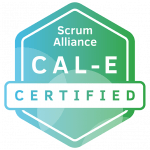
Agility Course
CAL-E
Certified Agile Leadership- Essentials Training
Upcoming Classes
CAL-E Course Introduction
Certified Agile Leadership Essentials (CAL-E) courses bring awareness and understanding to the foundations of agile leadership. Discover the way agile leaders think, focus, and behave. The focus on agile leadership essentials equips you to embark confidently on the journey toward leading with agility and championing agile transformation in your workplace
The goal of this workshop is to bring awareness and understanding of the foundations of agile leadership. Exploring the way agile leaders think, focus, and behave allows the participants to begin their learning journey regarding what it takes to lead in today’s workplace.
Organizations today are striving to stay on top of rapidly changing business needs and are coming to understand that the need to respond and adapt quickly is becoming increasingly important. Business leaders are now required to shift the way that they think about their role as a leader, their relationship to their employees, and the culture of their organization. Agile leaders are needed to help their organizations thrive in a volatile, uncertain, complex, and ambiguous (VUCA) world.
Read more about the requirements and prerequisites for this certification at CAL-E
Looking for more detail?
WHAT YOU'LL LEARN
The topics presented in this class include:
Understanding Why New Thinking And Approaches Are Required For An Increasingly Complex, Unpredictable And Volatile World.
The Intent behind these learning objectives is to help leaders recognize that leadership and management have lived on an evolutionary continuum and will continue to do so. Further, that the quickening pace of change will likely speed up new ways of leading even through our short leadership careers. Connecting the leader to a changing global workforce landscape and why new thinking, behaviors, cultures, and ways of operating are required to be effective in this new landscape.
- Global Challenges
- VUCA
- Complexity and Uncertainty
- Management Trends
- Organization Transformation
- Agile Leadership Benefits
A Different Type Of Leadership
Agile leadership is multi-faceted and may expose dozens of new pathways of learning. Learning from experience is important, as much as time to reflect and rationalize those learnings. Having a model or a framework that allows leaders to hold up a mirror and focus their improvements is a fundamental step to achieve continuous learning. On top of continuous personal development, it is very important to have a practical approach to interact with others that co-evolves with the organizational culture and serve as a texture for interactions. Good leaders can adapt their behavior and attitudes based on the situation at hand, rather than having a preferred leadership style.
- Mindset shift to support Agile approaches
- Structured leadership development approach
- Leadership interactions and culture
Self, Situational and Social Awareness
The intent of this section is to continue towards understanding how to improve control over actions and focus those actions towards achieving leadership effectiveness and reflecting on the importance of the awareness of the impact that their actions might have on the people around them. This awareness can sharpen the capability of a leader to effectively engage and interact with their groups, as well as increasing the likelihood that those groups will achieve the desired outcome.
- Self-Awareness
- Situational Awareness
- Social Awareness
Growth Mindset
The intent behind this section is to reflect on the importance of personal and professional growth and the fact that it involves believing that we can change, then examining and deliberately choosing our thoughts, feelings and behaviors and that feedback is the fuel for a growth mindset and an adaptive organization. By role modeling feedback on the leader personally, they will demonstrate vulnerability and openness to enrich a culture of continuous learning.
- Growth Mindset
- Incorporating Feedback


Respectful Engagement
The intent behind this area is that exposing more diversity of voices will lead toward improved outcomes in highly complex environments. Furthermore, the global workforce is becoming more creative and demands a higher level of contribution toward team and organizational goals. Leaders will learn different techniques compatible with the approach shared at point 3. Practicing should increase the understanding and increase the level of confidence in applying such techniques in the leaders’ own work environment.
- Respectful Conversations
- Engaging without Micromanaging
Prerequisites
- There are no pre-requisites for CAL-E
Professional Benefits
- Earn 8 PMI PDUs
- Earn 8 Scrum Alliance SEUs
- Complete the prerequisite to earn the Certified Agile Leadership-Essentials
- CAL-E badge and recognition on the Scrum Alliance webpage
- Upgrade your skill set to the demands of the market
- 2 years of membership to Scrum Alliance (this is covered by Agility Technology)
- Merit recognition as an CAL on the Scrum Alliance Website
- Attend exclusive CAL events with other leaders in Agile and Scrum
- Attract more recruiters and command a higher rate of pay
- Establish a gateway and milestone toward becoming CST®, CEC, or CTC
- Receive a free Premium subscription to the world's largest Agile assessment and continuous improvement platform, Comparative Agility®
Who Should Attend?
This course is great for anyone interested in advanced concepts and techniques for product management as well as:
- Technology Leaders
- Directors
- Managers
- ScrumMaster
- Product Owners
- Business leaders
- Executives
- Agile Coaches
- CIO
- CTO
Focus of the CAL course is not only to help you advance your certification level, but also help you to hone your skills in the “softer” aspects of leadership, like effective facilitation and communication amongst multiple teams and stakeholders. We focus on the following areas:
- Deeper learning of the agile leadership role
- Common Scrum and agile problems at the team and organizational level
- Improving team and organizational relationship dynamics
- Understand and leverage the motivations of individuals and teams to get better in Scrum
This course requires active participation and attention. Whether you join in person or live online, the day of instruction is broken up with breaks and breakout discussion sessions.
Steps to attain CAL-E Certification
- Step 1: Attend the CAL course instruction. You may find in-person, live online, and/or mentoring courses by visiting our course Search
- Step 2: Successfully complete all educator-designed components of an approved educational offering. This may include pre- or post-course work as deemed necessary by your approved educator to complete the learning objectives.
- Step 3: Accept the CAL License Agreement and complete your Scrum Alliance membership profile.
- Step 4: Validate at least 24 months of work experience specific to the role of Product Owner (within the past five years.) This can be met before or after attending the course. Work experience is entered and validated on your Scrum Alliance account.
